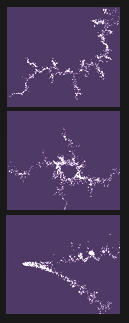How Does it Work?
A particle system of 2000 bits is animated.
Each particle, as it moves along, continually projects two rays: one slightly to the left, and the other slightly
to the right of its
direction of travel. The particle then asks itself which ray is aimed in a direction closer to the boundary of
the Set. Whichever ray is the closest determines a force applied to the particle in that direction. This causes the
particle to be continuously turning towards the boundary of the Set as it moves along.
|
The equation for the Mandelbrot Set tests the magnitude of Z, a complex number, to determine whether a given point in
the complex plane is inside or outside of the Set. If this value exceeds 2, all iterations from then on will
rapidly diverge towards infinity. All values outside of the Set, after iterations are stopped, will range from 2 to
infinity (with points closest to the boundary closest to 2).
If the value does not exceed 2 after the maximum number of iterations, its final value will lie within the range
of 0 and 2.
|
Every time a particle projects its two rays, it calculates the magnitude of Z at the ends of each ray to determine which
is closest to 2. The length of the ray is proportional to its distance to the boundary, with lengths being
shorter near the boundary - thus, the resulting velocitiy of the particle is smaller when it is near the boundary. However, since a particle
can often overshoot across one of the Mandelbrot Set's tendrils, it may end up weaving itself along the general arc of the
tendril, sometimes
falling off the end, where it encounters a strong gradient - this is presumed to be what
causes the curious launching effect.
|

|

